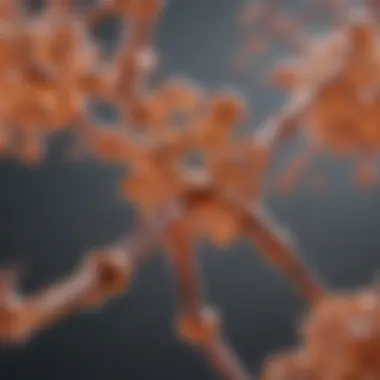Exploring the Science of Color-Changing Paper


Intro
Color-changing paper that reacts to moisture represents a fascinating intersection of chemistry and practical application. As this substance becomes prevalent in various industries, both scholars and practitioners must understand its underlying science. This paper reacts in distinct manners when exposed to different moisture levels. Thus, exploring the principles and reactions behind color-changing paper not only highlights its potential but also invites discourse on the implications of its usage.
This article provides an in-depth examination of how this innovative material has evolved. The insights gathered within will discuss the synthesis of these materials, their chemical processes, and the advancements that have led to current applications. Furthermore, it will challenge existing notions about traditional materials, encouraging a reevaluation of moisture reaction mechanisms.
Methodologies
Description of Research Techniques
Research into color-changing paper involves a multifaceted approach. Multiple scientific techniques are deployed to understand the chemical interactions at play. Spectroscopy is one of the most significant techniques. It allows for the analysis of how light interacts with materials, helping elucidate changes in color when moisture is introduced.
In addition, differential scanning calorimetry (DSC) offers insights into thermal transitions within these materials. This analysis enables researchers to examine how temperature affects the moisture level in color-changing paper, thus affecting its color response.
Tools and Technologies Used
Utilizing advanced tools is crucial for accurate research results. Here are critical components often involved in the study of wet-reactive materials:
- Spectroscopy Equipment: Tools like UV-Vis and FTIR spectrometers analyze optical properties and molecular structure changes.
- Microscopy: Scanning electron microscopes (SEM) provide detailed images of surface changes at a material level.
- Environmental Chambers: Used to control moisture and temperature in experiments, ensuring reproducible conditions.
The combination of these methodologies facilitates a comprehensive understanding of how moisture interacts with color-changing paper and illuminates its complex properties.
Discussion
Comparison with Previous Research
The innovations surrounding color-changing paper are a testament to a legacy of research into hydrophilic and chromogenic materials. Older studies focused primarily on dyes that reacted to simple chemical inputs. Recent advancements have shifted toward a more sophisticated understanding of hydrophilicity and light absorption in the context of moisture. Compared to previous research, this new material introduces possibilities that were not previously considered viable or effective.
Theoretical Implications
Exploring the theoretical frameworks behind color-changing paper opens avenues for various applications. It raises questions about sustainability, usage in packaging, and even safety indicators in products that require moisture sensitivity. The adoption of these materials can influence environmental practices by reducing waste from failures in achieving moisture control. Further studies may redefine existing theories about material science as reflected in the behavior of responsive materials.
Foreword to Color-Changing Paper
Color-changing paper, particularly those that react to moisture, represents a significant advancement in material science. This technology opens doors to a broader understanding of environmental interactions and innovative applications across various industries. The importance of color-changing paper lies in its ability to visually indicate moisture presence, making it a valuable tool in packaging, art, and safety technologies.
The relevance of this topic extends beyond mere aesthetic appeal. It serves practical functions in monitoring environments where moisture levels can have critical effects, such as in food safety or product storage. By leveraging the unique properties of wet-reactive materials, manufacturers can enhance their products, providing clear indicators of exposure, deterioration, or contamination.
Defining Color-Changing Paper
Color-changing paper refers to innovative materials engineered to change hue when exposed to moisture. This change is often a response to specific conditions such as humidity or the presence of liquid water. The mechanism behind this change can vary depending on the type of compounds coated onto the paper.
Typically, these papers are manufactured with specialized chemical compounds that react when they come into contact with moisture. The reaction can be reversible or irreversible, depending on the design intent. By simply observing the color shift, users can understand the moisture status surrounding the paper, which makes it an invaluable tool for various applications.
Historical Background
The concept of using materials that change color in response to environmental stimuli is not new. Early color-changing materials can be traced back to ancient civilizations, where craftsmen utilized different natural pigments that could respond to changes in surroundings.
However, the modern development of color-changing paper began in the late 20th century, with advances in polymer chemistry and nanotechnology. Researchers started to explore the combination of various chemical compounds which react predictably to moisture levels. These innovations allowed for the creation of highly sensitive materials suitable for commercial use.
In recent years, the application of color-changing paper has expanded beyond simple novelty items. It now plays a crucial role in sectors such as packaging, education, art, and even in safety mechanisms. As research progresses, further developments are expected, leading to enhanced functionality and broader utility in various fields.
The Chemistry of Color Change


Understanding the chemistry of color change is essential to grasp the principles of color-changing paper, particularly those that react to moisture. This chemical reaction is a result of complex interactions between various materials and compounds. This section will illuminate the mechanisms behind these transformations, the specific materials used, and the influence of pH levels. By studying these aspects, researchers and professionals can better appreciate how such materials can be utilized across multiple industries.
Chemical Mechanisms
Color-changing paper is primarily driven by chemical mechanisms that facilitate alterations upon exposure to moisture. When water interacts with the paper, it initiates a response in specific compounds embedded within the material. These compounds may include indicators, which undergo structural changes that result in a noticeable shift in color. This process can typically be attributed to at least two key actions: hydrogen bonding and electron transfer.
- Hydrogen Bonding: When moisture is present, water molecules form hydrogen bonds with certain components in the color-changing paper. This bonding can alter the stability of the compounds and lead to a change in their optical properties.
- Electron Transfer: Some color-changing compounds involve electron transfer that can be triggered by moisture. This may involve oxidation-reduction reactions where electrons are exchanged, altering the compound's chemical state and thus its color.
The intricate nature of these chemical processes makes color-changing paper not just a simple novelty item, but a potential material with significant implications for various applications.
Materials and Compounds Involved
The effectiveness of color-changing paper depends heavily on the materials and compounds involved in its manufacture. Various organic and inorganic compounds may be used, including indicators like phenolphthalein or specific metal complexes that change color when in contact with water. These materials are chosen for their ability to undergo visible change under specific conditions.
- Organic Compounds: Typically, organic indicators such as BTB (Bromothymol Blue) are commonly utilized. These compounds change color at certain pH levels when they interact with moisture.
- Inorganic Compounds: In some formulations, inorganic materials like transition metal complexes are integrated to provide more robust responses to varying environmental conditions.
- Microencapsulation Techniques: Utilizing microencapsulation allows for the controlled release of these compounds, essentially protecting them until a specific reactive condition, such as moisture, is met.
These materials create dynamic interactions that form the core of color-changing technology.
The Role of pH Levels
The role of pH levels is crucial in determining how color-changing paper reacts to moisture. Different substances exhibit varying colors at specific pH ranges; thus, maintaining a proper pH in the environment can greatly affect outcomes. Many color-reaction compounds are pH-sensitive and have a spectrum of color changes depending on the acidity or alkalinity of the environment.
- Acidic Conditions: Under low pH, certain indicators display one color, which may change or disappear when conditions shift to neutrality or alkalinity.
- Alkaline Conditions: Conversely, high pH levels can cause other compounds to reveal distinct colors compared to neutral pH circumstances.
Maintaining control over pH levels can enhance the precision of color change in practical applications, making it an important consideration in manufacturing color-changing papers.
"Understanding these fundamental principles equips professionals with the tools to innovate further in the field of materials science."
The chemistry behind color change not only highlights the science at play, but it also opens up pathways for enhanced material utilization in industries ranging from packaging to art and design.
Manufacturing Processes
The manufacturing processes behind color-changing paper are crucial for achieving the desired properties and functionality of the product. From the initial selection of raw materials to the final treatments applied to enhance performance, each step is essential. Understanding these processes helps to appreciate how these innovative materials respond to moisture and the potential applications that arise from their unique characteristics.
Production Techniques
Various production techniques are employed in creating color-changing paper. One prominent method involves impregnating traditional paper with specific wet-reactive chemicals. These chemicals usually belong to families such as acid-base indicators or dye complexes which undergo a change in their molecular structure when exposed to moisture. The incorporation of these materials requires precision in both dosage and application to ensure uniform results.
Another technique is coating. In this method, a layer of moisture-reactive compounds is applied to the surface of the paper. Coating allows for fine control over the amount of reactant on the paper while preserving the underlying properties of standard paper, such as texture and printability. The choice of coating material and its interaction with the base paper significantly influence the performance characteristics of the final product.
The drying phase is also significant. After applying treatment solutions or coatings, the paper must be dried under controlled conditions. This prevents premature reactions and ensures that the color change function remains intact over time.
Quality Control Measures
Quality control measures are vital in the production of color-changing paper. They ensure that the product meets required standards and performs as expected. Several aspects are monitored throughout the manufacturing process.
First, the raw materials undergo strict quality assessments to ensure consistency and purity. Any irregularities in the chemical composition can lead to performance issues.
Moreover, during production, tests are conducted at various stages to evaluate how well the paper responds to moisture. The color change should be consistent and reproducible under defined conditions. Often, this involves using controlled environments that simulate real-life scenarios.
Post-production testing is another essential step. Here, samples of the finished products are subjected to performance tests. This often includes evaluating how quickly the paper changes color and the longevity of that color change once exposed to moisture.
Quality control not only aids in maintaining the performance of the product but also protects the brand integrity and Trust.


Finally, feedback from end users can be integral to improvement processes. Adjustments are made based on performance feedback in various applications, such as safety labels or packaging materials. This creates a continuous loop of enhancement, ensuring that the color-changing paper aligns with market needs.
Applications of Color-Changing Paper
The importance of color-changing paper extends beyond aesthetics. It acts as a bridge between chemical science and practical applications in daily life. This transformative material holds potential in various sectors, highlighting its significance in both academic and commercial realms. It represents an intersection of art, technology, and functionality, promising advancements that can revolutionize current practices.
Use in Packaging
Color-changing paper has found its way into the packaging industry. Its ability to indicate moisture levels provides a significant advantage. For example, products that are sensitive to humidity can benefit from this technology. When moisture levels rise, the paper responds by changing color. This behavior serves as a visual cue for both manufacturers and consumers. Companies can utilize this feature to prevent spoilage or degradation of goods.
In practical terms, this can enhance the safety and longevity of perishable items. Consider food products like dried fruits or baked goods. When packed with color-changing paper, the package can notify users about optimal storage conditions. If moisture alters the color, consumers are alerted to a possible quality issue.
Role in Art and Design
The art world is embracing color-changing paper as a medium of expression. Artists are leveraging its interactive qualities to create dynamic artwork. This material facilitates a dialogue between the piece and its viewer, as the changing colors can express different states or meanings depending on the environment. The reactive nature of the paper introduces an element of surprise and intrigue in art installations.
In design contexts, color-changing capabilities can elevate branding strategies. For example, a logo that adjusts color based on humidity not only stands out but also engages customers in an innovative manner. Designers appreciate the versatility—color-changing paper can be applied to various surfaces and products, from stationery to packaging solutions. This technology supports creativity while offering practical functionality.
Innovations in Safety Mechanisms
The safety mechanisms employing color-changing paper are particularly noteworthy. In industries like pharmaceuticals, where product integrity is paramount, moisture sensitivity is critical. Color-changing paper can serve as an early warning system for compromised containers. A visible color change could indicate a breach in packaging, alerting users before the contents are affected.
This feature is crucial for protecting sensitive materials such as medications, which degrade with moisture exposure. Implementing this technology directly impacts public health and safety. As the demand for reliable safety indicators grows, the integration of color-changing paper in safety mechanisms is likely to expand further.
Color-changing paper is not only a visual tool but a practical asset that reinforces product safety and quality assurance.
Overall, the spectrum of applications for color-changing paper combines innovative thinking with practical solutions. The versatility in packaging, art, and safety mechanisms illustrates its potential to influence various fields significantly.
Environmental Considerations
The exploration of color-changing paper brings to light several important environmental considerations. As this innovative material gains traction across various industries, understanding its impact on the environment becomes imperative. Topics such as sustainability, efficient use of materials, and the ability to safely dispose of or recycle these products must receive careful scrutiny.
Sustainability of Materials Used
The sustainability of materials used in color-changing paper is a critical issue. Many formulations include dyes and chemicals that can be concerning from an ecological viewpoint. When assessing sustainability, it is essential to prioritize materials that are derived from renewable sources or have minimal environmental impact.
Studies indicate that natural dyes and plant-based polymers can serve as alternatives for creating color-changing effects. Utilizing water-soluble polymers and non-toxic substances can significantly reduce the ecological footprint of production. Moreover, the lifecycle assessment of materials involved can offer insights into their environmental impact, from production through to disposal.
An increasing focus on biodegradable materials is noticeable in the industry. This shift not only meets consumer demand but also aligns with regulatory movements promoting green technologies. However, achieving true sustainability requires extensive research and diligence in sourcing materials. The long-term benefits of sustainable practices are evident, including lower emissions during fabrication and an overall reduction in waste.
Disposal and Recycling Challenges
Disposal and recycling challenges present valid concerns regarding color-changing paper. While traditional recycling processes are well-established for paper products, those containing specialized inks and reactive materials complicate this efficiency.
Many color-changing papers are not easily recyclable due to their chemical components. The dyes often utilized may not break down or may contaminate recycled paper batches, leading to potential feasibility issues for recycling programs.
Furthermore, educating consumers about disposal methods is vital. Practical strategies, such as advocating for separate waste bins for these products or promoting composting where suitable, could alleviate some concerns.
"Effective management of color-changing paper waste can help alleviate pressure on landfills and foster a culture of responsible consumption."
Addressing these disposal and recycling challenges is quite necessary. Industry stakeholders, including manufacturers and recycling plants, must collaborate to implement innovative solutions. Exploring technologies that enhance the recyclability of color-reactive materials could pave the way for a more circular economy. This is a fundamental step in ensuring that advancements in material science do not come at too high of an environmental cost.
Future Prospects


As we look into the future of color-changing paper, several factors emerge that highlight its significance within various sectors. Advancements in materials science continue to enhance the functionality and applications of wet-reactive materials. The ongoing exploration of new compounds offers opportunities for improved performance, making color-changing paper potentially more effective in response to moisture variations.
Innovation in this field can lead to safer packaging solutions. For instance, integrating these materials in food packaging could signal spoilage, promoting consumer safety and reducing waste. Furthermore, the interactive nature of such materials can revolutionize education and art by providing dynamic tools for illustrative purposes.
Investment in research will expand our understanding of how to optimize these materials, focusing not only on their chemical properties but also on durability and production efficiency. As the technology progresses, it raises questions regarding ecological impacts and how these materials can align with sustainability efforts.
Emerging Research Trends
Current research trends in color-changing paper emphasize innovative methodologies for developing and testing new materials. Scientists explore various polymer combinations that can react to environmental stimuli such as moisture and temperature. There is also a push towards bio-based materials. These materials not only provide a sustainable alternative to traditional substances but also maintain the reactive properties desired in color-changing applications.
Key areas of investigation include:
- Development of nanocomposites that enhance color response accuracy.
- Exploring dye-sensitized mechanisms that are responsive in real-time.
- Assessing the integration of smart materials that can communicate changes via digital platforms.
This research has broader implications, particularly in how consumer products are designed and perceived. The convergence of art and science in creating responsive designs can lead to enhanced user experience and greater engagement.
Potential Market Growth
The market for color-changing paper holds great potential for growth. Sectors such as packaging, education, and safety are ripe for innovation, driven by the need for more interactive and informative products. Market dynamics suggest that as consumer awareness of the importance of sustainable packaging increases, the demand for color-changing paper will correspondingly rise.
Industry experts predict substantial growth due to:
- Increased demand for smart packaging solutions in the food and beverage sector.
- Application in pharmaceuticals, where moisture detection can prevent product degradation.
- Utilization in educational materials that engage students through real-time interaction.
As companies invest in research and development, the competitive landscape will also evolve. Market barriers will likely diminish as production techniques become more standardized, resulting in lower costs and greater accessibility. This trajectory not only signifies the expansion of market opportunities but also emphasizes the relevance of ongoing research to refine and optimize color-changing paper.
Challenges and Limitations
The exploration of color-changing paper, especially those that react to moisture, presents a variety of challenges and limitations that need consideration. Understanding these factors is essential, as they impact both the practical applications of this innovative material and its future trajectory in research and markets. Addressing technical constraints alongside economic considerations sets the foundation for navigating potential breakthroughs or setbacks in the field.
Technical Constraints
One of the most significant hurdles in developing color-changing paper relates to the technical aspects involved in its production. Manufacturing processes must ensure uniformity in color change and responsiveness, which can be challenging given the variability of moisture levels.
The chemical compounds used must undergo careful selection. Not all wet-reactive materials yield stable or reliable results; thus, consistent performance under different environmental conditions remains a priority. The inherent sensitivity of these materials may lead to inconsistent color changes when exposed to varying levels of humidity, complicating their use in real-world applications.
Moreover, factors such as ambient light and temperature can also alter the effectiveness of moisture detection, introducing variables that can impact the functionality of the paper. Solutions to these challenges often involve extensive research, development, and testing, which can slow the overall progress of creating reliable products.
Economic Considerations
From an economic perspective, the path towards widespread adoption of color-changing paper is complicated. The cost of materials is a crucial factor; high-quality chemical compounds that ensure effective responsiveness may be expensive. This can affect the retail price of products made from color-changing paper, making them less accessible to consumers and limiting market penetration.
Additionally, the target industries remain an essential consideration. Sectors that could benefit from this technology include packaging, art, and safety mechanisms. However, many companies may be hesitant to invest due to the unpredictability of returns on investment given the current state of the technology. The initial research and development phase often demands substantial capital, which can deter potential investors.
Finale
The conclusion section serves a pivotal role in summarizing the discoveries about color-changing paper that reacts to moisture. This innovative material holds significant implications across various domains in technology and design. It encapsulateskey findings and illustrates why understanding the chemical and physical principles behind it is vital for further exploration and application.
Summary of Key Findings
In reviewing the insights gained throughout the article, several critical points emerge:
- Chemical Reactions: We elucidated how color-changing papers engage with moisture at a molecular level. The compounds used in these materials are sensitive to environmental changes, effectively demonstrating reactions that manifest as visible color shifts.
- Diverse Applications: The versatility of color-changing paper was highlighted, particularly in packaging, art, and safety mechanisms. Its ability to signal moisture presence can prevent spoilage or detect hazardous conditions.
- Manufacturing Techniques: We examined advanced production methods that ensure quality and consistency of the color-changing effect, emphasizing the importance of maintaining rigorous quality control measures.
- Economical Viability: Economic factors, such as production costs and market demand, were considered, impacting the scalability of these materials.
These findings collectively underline the transformative potential of color-changing paper in various fields, indicating a shift towards more intelligent materials.
Implications for Future Research
The exploration of color-changing paper also opens avenues for future inquiries:
- Innovative Formulations: Research into alternative compounds for color reaction could enhance sensitivity and expand the functionality of moisture-responsive materials.
- Integration in Technology: Further examination of how color-changing paper can be incorporated with digital technologies could lead to smart packaging or interactive designs.
- Environmental Impact Studies: As awareness of sustainability grows, research dedicated to the ecological footprint of these materials will be crucial. This includes examining biodegradable options and their life-cycle impacts.
- Cross-Disciplinary Collaborations: Encouraging interdisciplinary collaboration can provide new perspectives. Contributions from material science, design, and environmental science can propel the application of color-changing paper into new territories.



